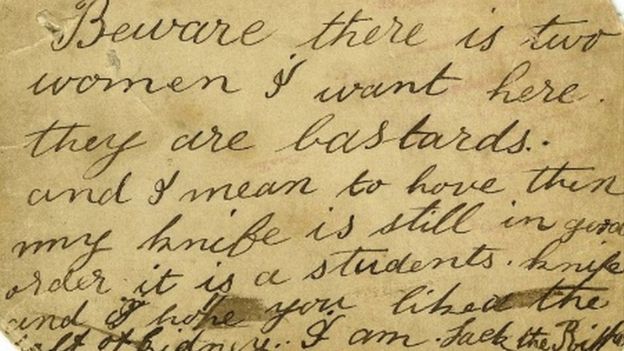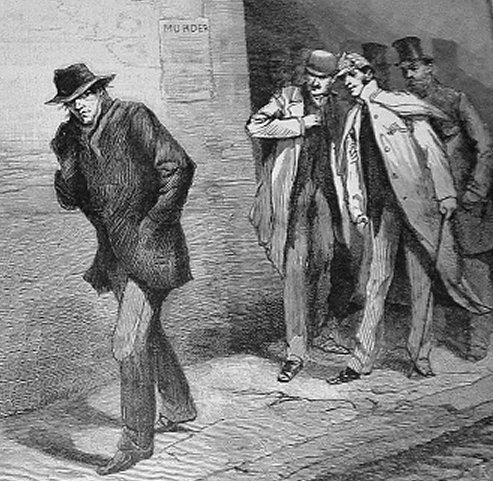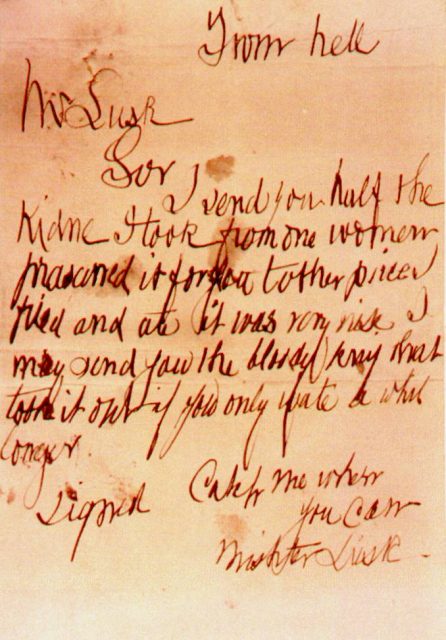Four women were already dead in the East End district of Whitechapel, brutally slain by an unknown murderer the press had dubbed “Jack the Ripper,” when a postcard that was dated October 29, 1888, showed up in the mail at Ealing Police Station.
“Beware there is two women I want here and I mean to have them my knife is still in good order it is a students knife and I hope you liked the kidney,” it read. “I am Jack the Ripper.”
While the city was on edge, fearful of the killer stalking the East End, there had not been a murder in recent weeks. The last of the horrific slayings–dubbed the “Double Event” as two prostitutes, Elizabeth Stride and Catherine Eddowes, had their throats cut within two hours of each other–was on Sunday, September 30th.
However, shortly after this postcard was sent, on the morning of November 9, 1888, Mary Jane Kelly, a prostitute in her mid-twenties, was found dead in her East End home, 13 Miller’s Court. Her body was more mutilated than any of the other victims. She was the fifth woman whom experts believe was killed by Jack the Ripper–often called “the canonical five”–and although other women were found murdered in the area over the next few years, it’s uncertain if those deaths are connected to the first five.
The original 2.75 inch by 4.75 inch card with its threatening scrawl was auctioned at Grand Auctions Ltd., in Folkestone, Kent, for $30,000 (£22,000) on May 1, 2018. The final price could be closer to $43,000 once an auction premium is paid. The postcard once belonged to a police constable who was given it as a memento when he retired in 1966. His widow put it up for auction.
According to the BBC, the auctioneers stated: “There is mention of his ‘students’ knife in our card. Some believe that the ripper had some medical training from the way he cut up his victims, but this is not universally accepted. The kidney that was mentioned also appears in the ‘Letter from Hell’, another Ripper letter, where the writer stated he had fried one of his victim’s kidneys and ‘it tasted nice’.”
The auctioneers said, “The card is definitely of the period and has police provenance.”
But who wrote it? The issue of letters sent by “Jack the Ripper” is a controversial one. The most famous one is the “Dear Boss” letter, sent to the Metropolitan Police on September 29th, beginning with “I keep on hearing the police have caught me but they wont fix me just yet. I have laughed when they look so clever and talk about being on the right track.” Another was sent on October 1st in the same handwriting, “You’ll hear about Saucy Jack’s work tomorrow double event this time…” Although the letter indicates knowledge of murdering Stride and Eddowes, it could have been written and posted after those murders were common knowledge.

There is a theory that the two most famous letters were press hoaxes, and it is possible that all of the letters and postcards supposedly sent by Jack the Ripper came from journalists trying to boost circulation, pranksters, or someone mentally unbalanced.
Mary Jane Kelly’s body was discovered that morning because her rent was due.
Jack McCarthy was landlord of many properties in Whitechapel occupied by the destitute, ranging from the respectable working poor to thieves, gamblers, hopeless alcoholics, and “Unfortunates,” the Victorian euphemism for prostitutes. Around 10:30 A.M., McCarthy told his assistant, Thomas Bowyer, to try to collect the rent in arrears at No. 13 Miller’s Court, a ground-floor room on a narrow 20-foot-long cul de sac of Dorset Street.
Even within the East End parish infamous for its poverty, crime and filth, Dorset Street was in a class all its own. Part of the “wicked quarter mile,” it was a 130-yard-long street almost entirely occupied by common lodging houses and pubs. As grim as these lodgings were, the alternative–“sleeping rough”–was worse. Many of the poor struggled on a daily basis to pay for their “doss house” bed. The September 8th victim of Jack the Ripper, 47-year-old Annie Chapman, was murdered while trying to earn enough money on the streets to pay the nightly charge at her common lodging house on Dorset Street.
At 10:45 a.m. Thomas Bowyer knocked on the door of 13 Miller’s Court. In April of that year a Billingsgate Market fish porter, Joseph Barnett, and his pretty young companion, Mary Jane Kelly, had moved into the room, costing 4s/6d a week. It was 10-foot-square with two small windows, a bed, two tables, and a fireplace. In Spitalfields, this was a home better than the average.
But Barnett lost his job. He moved out after quarreling with Mary on October 30. She was living there alone, a common sight in the neighboring pubs, drinking with friends. Although she told those friends she was afraid of Jack the Ripper, Mary had turned to prostitution to support herself. It was not her first time earning her living as an “Unfortunate.”
When McCarthy came, no one answered the knock on the door. The small window next to the door had been broken weeks earlier by Barnett or Mary and was blocked by a heavy material hanging from the inside. Bowyer pushed aside the material to see inside. Seconds later, sickened and horrified, he ran to fetch landlord McCarthy.

An inspector joined the men at the Miller’s Court window but did not provide initiative. The group summoned a doctor. The doctor had the presence of mind to call for a photographer. But the door was locked–McCarthy had no key–and the group waited outside, first for trail-sniffing bloodhounds that never showed up and then for someone to make the decision on how to enter the room. At 1:30 P.M., McCarthy finally broke through the door with a pickax. This delay made it difficult to set the time of death. Some put it as early as 1 A.M., others say it was as late as 8 A.M., with the murderer taking advantage of police being preoccupied with the Lord Mayor’s Show.
Two days later, Mary Jane Kelly was formally identified at the mortuary by Barnett, who was cleared of suspicion. As the city responded with panic, doctors performed their post-mortem and police gathered what information they could. It had been a cold night of drizzling rain. No one had seen or heard anything suspicious besides a soft female cry of “Oh, murder” at about 3:30 A.M. That cry was ignored.
It seemed incredible–even supernatural–that she’d been killed in such a crowded area. Despite the presence of hundreds of people nearby, sleeping fitfully, coming and going all night, men in and out of pubs and prostitutes returning to their rooms to warm up before going back on the streets, no man was seen leaving Mary’s room, covered with blood or otherwise, although Miller’s Court was just a little over a yard wide and lit by a gas lamp.
Mary herself was seen and heard by neighbors throughout the preceding day and sporadically that night as she looked for business. Just before midnight, a neighbor saw Mary lead a man with a “blotchy” face and a thick “carrot” mustache to her room. At 2 A.M., an acquaintance spotted Mary with a man on Commercial Street, 5 foot 7 or so, in his 30s, “respectable appearance.” After sharing a laugh and a kiss, they walked together to Dorset Street and toward her home. Was either of these men her killer?
One of the reasons there was so much fascination with Mary Kelly, then and now, is she was young and pretty. She was “fair as a lily” and had “blue eyes and a very fine head of hair which reached nearly to her waist.” She “was on pleasant terms with everybody,” one contemporary said. Her landlord McCarthy said she was “a very quiet woman when sober but noisy when in drink.”

Barnett testified as to his dead lover’s background. She told him she was born in Ireland and went to Wales when young, marrying a “very young collier.” After he died, she went to Cardiff and became a prostitute. A friend confirmed that Mary said she was originally from Ireland. Mary talked of receiving letters from a beloved mother and hoping to reunite with her and live there.
Nonetheless, in the many years since her death, no fact about Mary Jane Kelly’s background has been verified. Despite the efforts of many Ripper scholars, there are no records of her birth or marriage or residency in Ireland or Wales. No member of her family attended her funeral or came forward after her murder; no one could find evidence of the young husband’s life or death. There is not a trace of her to be found before she came to London. This was not the case for the other four women thought certain to have been killed by the Ripper. Researchers have records of birth and marriage, employment, even a wedding photo of one woman.
It is possible that Mary Jane Kelly used a false name the entire time Barnett and their friends knew her and she invented all the details and names of family and husband.
On Monday November 19th, 1888, the woman known as Mary Jane Kelly was buried at St. Patrick’s Catholic Cemetery in Leytonstone. Barnett and her friends could not pay for her funeral; the expenses were met by a sexton of Shoreditch.
Thousands attended the six-mile-long procession, some straining to touch her coffin. Men removed their hats; women called out, “God forgive her.” Two mourning carriages followed carrying Barnett and five women friends. The coffin was carried to an open grave listed as No. 16, Row 67.
